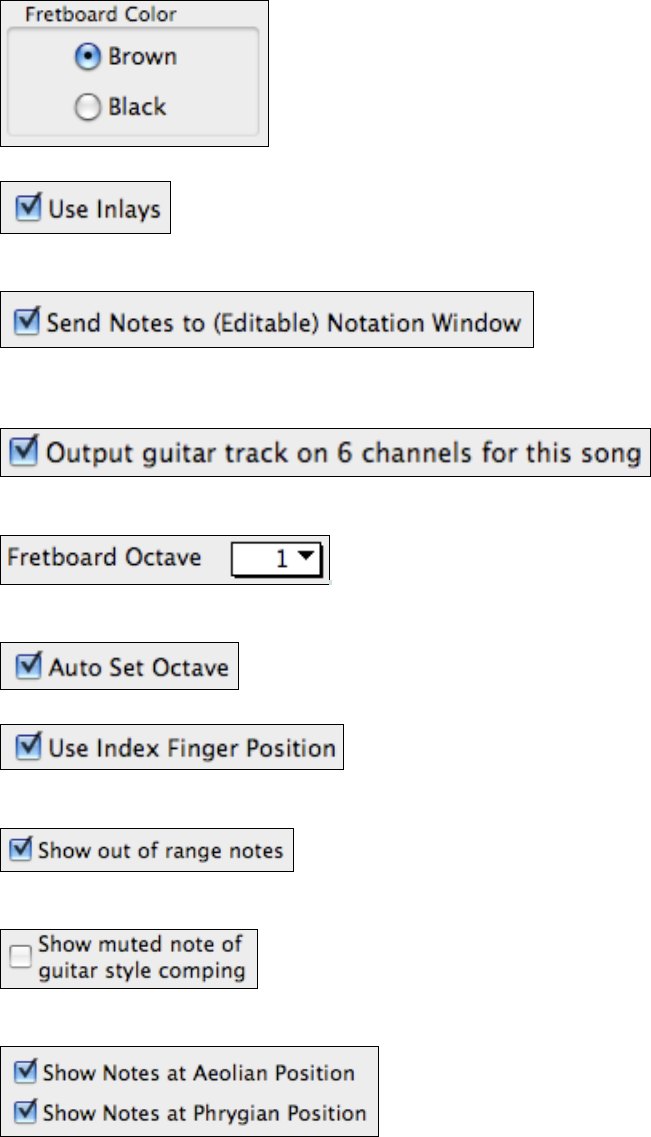User Guide
Table Of Contents
- PG Music Inc. License Agreement
- Table of Contents
- Chapter 1: Welcome to Band-in-a-Box!
- Chapter 2: QuickStart Tutorial
- Chapter 3: Band-in-a-Box 2010.5 for Macintosh
- Welcome to Band-in-a-Box 2010.5
- New Features in Band-in-a-Box 2010
- More New RealTracks
- QuickStart Tutorial
- Quick Song Settings
- Save Default Mix
- Improved Audio Rendering
- DAW Plug-in Mode
- Freeze Tracks
- RealTracks Enhancements
- New Favorite Songs/Styles Dialog
- Rendering Tracks
- StylePicker Enhancements
- New in the StyleMaker
- Chapter 4: The Main Screen
- Chapter 5: Guided Tour of Band-in-a-Box
- Chapter 6: Band-in-a-Box PowerGuide
- RealTracks
- RealDrums
- Song Settings
- The Chordsheet
- Chord Preview/Builder
- MIDI file “Chord Wizard”
- Applying Styles
- The StylePicker
- Playing, Pausing, and Stopping Songs
- Changing Volume, Panning, Reverb, Chorus, Bank
- Freeze Tracks
- Saving Songs
- Preferences – User Settings
-
- Show Chords with push/rest chars
- Metronome During Recording
- Harmony Volume Adjust
- OK to Load Style with songs
- Write Guitar part on 6 channels
- Turn External Keyboard’s Local On at end of session
- OK to beep with messages
- OK to prompt to reduce/expand
- For Roman Numerals in minor keys, use relative major
- Save Button on main screen works as Save As
- Name MIDI files with .MID extension
- Allow larger fonts on Chordsheet
- Color for Chordsheet Area
-
- Other Editing Features
- MIDI Setup
- The JukeBox
- Chapter 7: Notation and Printing
- Chapter 8: Automatic Music Features
- Chapter 9: Recording Tracks
- Chapter 10: Audio Features
- Chapter 11: Wizards, Tutors, and Fun
- Chapter 12: User Programmable Functions
- Chapter 13: CoreMIDI and Apple DLS Synth
- Chapter 14: Reference
- PG Music Inc.
- Index
- Registration Form

Chapter 8: Automatic Music Features
163
The guitar will display information on channels 11 to 16 on strings 1 to 6 if Multi-Channel Mode is set to = On
(default). Channel 11 is referred to as the “base channel” (default = 11). You can edit notes on the Notation to set
the channels of the notes. Guitar controllers will also record information in this manner, so you can record on a
MIDI guitar and see the display on the Guitar Fretboard. The base channel is normally 11, but you can set it to any
channel (e.g. if set for channel 5, this would mean that channels 5 to 10 would be the guitar channels).
The Fretboard Color can be brown or black (default=brown).
If you elect to not display note names, you can select “Use Inlays” and a guitar inlays will be displayed along the
neck.
If Send Notes to (Editable) Notation Window is set, when you click on the Guitar notes (and the Notation window
is open in Editable Notation mode or Staff Roll mode) the note will get inserted at the current time line on the
Notation window.
If you would like to have Melody and Soloist parts written specifically for guitar, set this to “Yes.” Then the notes
that are played on the six different strings will be assigned to six separate MIDI channels.
You can set the Fretboard Octave. For example, if the music is very low, and you need to boost the octave to
display it on the guitar, set the guitar octave to 1 or 2.
There is an AutoSet Octave setting (discussed elsewhere). If selected, the Guitar Octave is set automatically.
Use Index Finger Position: If set, the scale will use the “index finger” to play notes that are one fret outside of the
normal position, instead of the little finger.
Show out-of-range notes: If set, any note will be displayed on the guitar, regardless if it is the range of the guitar or
not.
Show muted note of guitar style comping: For the three-note Jazz voicings, there is a high note that is applicable
to the chord but is either not played or muted. You can choose to display this note on the guitar fretboard.










